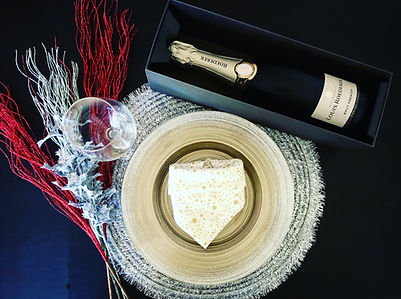FOOD PAIRING
WHAT YOU NEED TO KNOW
FOOD PAIRING

Champagne is one of the most versatile wines for pairing with food – it simply goes with everything.
It’s all about balance.
Pairing your champagne with the proper dish will enhance your tasting experience.
So, what culinary delights pair best with Champagne?
Of course, it entirely depends on your mood and taste du jour.
For you, the ideal mix might include a basket of extra crispy French Fries. Perhaps you’d prefer a steak
dinner with a side of mash-potatoes? Or if you have a sweet tooth, you might go for a decadent cheesecake or ice-cream dessert?
Several factors & variations need to be taken into account before pairing champagne with food:
The Grape Varietals:
There are 3 primary grapes used to make Champagne: Pinot Noir, Meunier and Chardonnay.
How they are blended (or not) together will determine the style of the champagne.
Champagne Style:
. Blanc de Noirs: made with 100% black grapes (Meunier and/or Pinot Noir)
. Blanc de Blancs: made with 100% white grapes (Chardonnay)
. Rosé:
The Level of Sweetness:
- Brut Nature (0-2g/L): Brut Nature is also known as zero dosage, ultra-brut, brut sauvage and non-dosage.
It means that the Champagne will be bone dry with no added sugar.
- Extra Brut (up to 6g/L): has no detectable sweetness with 0-6g/L of residual sugar.
- Brut (up to 12g/L): Brut has no or barely detectable sweetness, ranging from 0 to 12g/L of residual sugar.
It is by far the most popular labelling term, with approximately 95% of Champagne production made in this style.
- Extra Sec (12-17g/L): is also known as Extra Dry. With 12- 17g/L of residual sugar, there will be some detectable sweetness in the Champagne.
- Sec (17-32g/L): can be translated to dry, however there will definitely be a noticeable sweetness to these Champagnes.
- Demi-Sec (32-50g/L): will have between 32 to 50g/L of residual sugar.
- Doux (more than 50g/L): is a very sweet style of Champagne with more than 50g/L of residual sugar.

The Age Profile of the Champagne
Vintage: All grapes used to make a vintage champagne are harvested from one year and the year appears on the bottle. They must age a minimum of 36 months on the lees. Most are aged for at least 4 years and often more.
Non-Vintage: is a blend of wines made from grapes harvested in different years. It accounts for about 90% of all champagne produced. Non-vintage champagne must age for a minimum of 15 months on the lees in the cellar.
Tête-de-Cuvée: is the term the Champenois use to describe their very best (and most expensive) bottlings. They’re also called Prestige Cuvées. Tête de cuvées are almost always vintage Champagnes.
Once you have a handle on these variations, you can confidently decide on what champagne to pick to accompany your meal.
As for the proper time to drink Champagne, the rule is there are no rules.
It’s never too early for a glass of bubbly!



